This Mark III was the last of the genuine Nortons. In October of 1977 the final Norton rolled off the line, with the side
panels reading “850 Commando Electric Start.”
The engine was an air-cooled parallel twin, inclined forward a few degrees, with two overhead valves per cylinder. A pair of Amal Concentric carbs fed fuel into the cylinders, with coils and points sparking the plugs. The whole engine/transmission/swingarm used an Isolastic Anti-Vibration System, with rubber mounting components serving to keep the vibes away. And, of course, an electric leg.
Slip back to November of 1948, almost 30 years before. At the Earls Court show, the annual offering of new models at this London exhibition hall, Norton rolled out the Model 7, a 500cc vertical twin. The engine design was certainly not an original idea, as Edward Turner had done this for Triumph in 1937, but one of his assistants, Bert Hopwood, had moved to Norton in 1947 as Chief Designer.
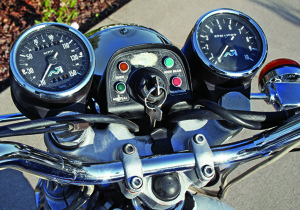
The vertical twin was in the late 1940s what the UJM design (the Universal Japanese Motorcycle, an air-cooled in-line four that was initiated by Honda’s CB750 in 1969) was in the 1970s. Many of the British motorcycle manufacturers—AJS, Ariel, BSA, Matchless, Royal Enfield—went to the vertical-twin design because it worked, and people wanted it. Coincidentally, Hopwood worked at many of these factories over his 40-year career.
The Model 7’s frame was a full cradle with plunger rear suspension, used by Norton’s ES2 500cc single; the chassis plays a major role in this story. The follow-up model was the 1952 Dominator 88, using more or less the same engine, but this one was housed in a Featherbed frame with a swingarm rear suspension having twin shock absorbers. In ’56, the engine was bored and stroked to make it the 600cc Dominator 99. The magneto went away in ’58, and coil ignition came in. In ’61, the engine was stroked to produce a nominal 650cc. In 1962, Hopwood’s essential engine was bored out yet again to come up with the 750cc Atlas—it had a bore of 73mm and stroke of 89mm, equaling 745cc. This was well beyond Turner’s dictates that the best parallel-twin engine would be no more than 650cc running at a maximum of 6,500 rpm. Run an Atlas up to that rpm and the fillings would fall out of your teeth.
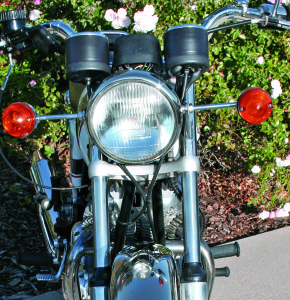
The British motorcycle industry was falling apart, much of it due to the vibration on the vertical twins. So Norton hooked its chief engineer, Bernard Hooper, up with a new hire, Stefan Bauer, who had been working with Rolls-Royce. Knowing that if they could isolate the engine from the rider, sales would improve, so they came up with the Isolastic system—Hooper holds the patent. At the front of the engine a spindle ran through two holes, with a rubber doughnut on each end. The same setup was on the back where the swingarm came through. The pistons and crankshaft whirr round and round, vibration builds and is dissipated through the rubber. Knowing that nothing stays quite the same with all that vibration, Hooper and Bauer arranged the Isolastics so that they could be loosened or tightened, using shims.
Introduced as a 750 in 1968, the riding public loved the Commando. Racers tightened things up for a better feel to the handling, putting up with increased vibes, while the lazy day-rider just let things go—ending up with a rather rubbery handling situation. Most people who have ridden aged Commandos have commented on the wobbly feeling—due only to lack of maintenance.
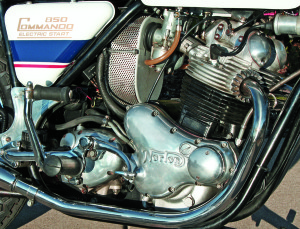
A second problem was power. The 750 was rated at 51 horsepower at 6,250 rpm, but after the introduction of the Honda CB750 the Norton marketing types felt more power was needed. In January of 1972 Norton offered the Commando with the high-compression (10:1!) Combat engine, claiming 65 horsepower at 6,500 rpm. Which it might well have put out—until it exploded.
Well, heck, if that won’t work, let’s just make a bigger engine. So in 1973 that old Hopwood device was bored out yet again, this time to 77mm, giving a total of 828cc—call it an 850. With a modest 8.5:1 compression ratio, the factory claimed 60 horses at 6,200 rpm. About the only internal modification was a slightly lighter flywheel to compensate for the heavier pistons. With a small fairing and a change in the gearbox sprocket, a very carefully fettled 850 was timed at 142.75 mph; this feat got headlines. For ’74, the Mark II models were on the market with minor styling changes.
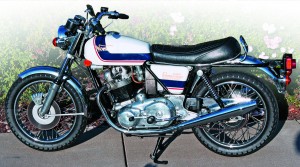
Early in ’75 the Mark III entered showrooms with two models, the sporty Roadster and the touring Interstate. By then U.S. law had standardized shift patterns and Norton had to swap the brake pedal with the gear shift. Not a problem, though now the gearbox was fixed, and the primary chain had an automatic hydraulic tensioning device. The Commando had been given a front disc brake in 1972, and with this conversion got a rear disc as well.
To simplify maintenance, the Mark III models had easily adjustable front and rear Isolastic units, requiring no special tools. A sloppy suspension was the rider’s fault, not the manufacturer’s.
Of great interest was the electric starter. This was a Prestolite device which was fitted right behind the left cylinder, roughly where the magneto had been until 1958, and a series of gears went down to a sprag one-way clutch that was fitted to the crankshaft. Pull in the clutch lever (normal clutch, not sprag), kick through, free the plates, open the petcocks, tickle the carbs, turn the ignition on, and push the button. The company recommended “starting in neutral with the clutch disengaged.” If the engine was warm and the battery fully charged, it might start. But the 12-volt battery was just not strong enough to give the engine any real spin. If it did not start right away, the human leg would have to do the work; Norton had the good sense to leave the kickstarter in place. Anybody riding a Mark III today has probably installed a stronger Nippondenso starter…the marvels of progress.
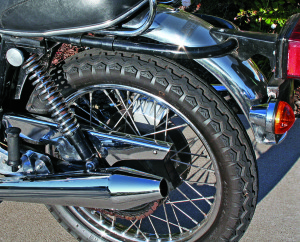
However, by 1976 Norton’s finances were, in a word, disastrous, and banks were calling in their loans. Production of the Hopwood-engined motorcycles ceased in the fall of 1977.
PS: But is Norton back in the game? In 2010 the new Norton Motorcycles brought a stock Norton 961SE out to the Bonneville Salt Flats where it ran a record-breaking 129.38 mph. This bike runs an air-cooled, 961cc parallel twin with 270-degree crankshaft, two-valve OHV cylinder heads, fuel injection and gear-driven counterbalancer and makes an estimated 84 rear-wheel horsepower.
There may be hope.
Year/Model: 1975 Norton 850 Commando Mark III
Owner: Jim Gerpheide, San Luis Obispo, California
Words and pictures by Clement Salvadori
(This Retrospective article was published in the August 2012 issue of Rider.)



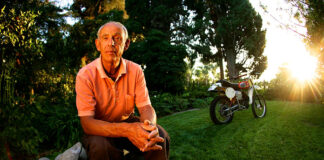




The 1975 Norton 850 Commando E-start (that I bought new in Phoenix AZ) did not have the style air box that is shown in these pictures. They used a flat, slip in foam filter. Did they come in both styles?
I have a 1974 850 (no e-start) and it has the big paper style filter, but I thought all of the 1975 units had the flat foam.
Thats the wrong air cleaner, I bought a brand new Interstate in 75 and it had the foam one. Also, the article is wrong, the Mk III was available as an Interstate, Roadster, Hi Rider and John Player. I remember staring at that poster for weeks waiting on my bike to arrive.
Forgot to mention, those are wrong mufflers too, they came with fugly ones with a black cone stuffed in the end.
I agree with your assesment. I bought my 1975 Norton 859 MK111 new in Phoenix AZ. It had the reverse cone mufflers and the foam box filter. Still runs great. I have 48,000 miles on it. Pea shooter mufflers, and a after market 4 brush high torque starter with a gel style battery (starter works fantastic, also had the original carbs “sleeved” and it idles very nice! Almost forgot…changed the headlight wiring to work directly off the battery using a halogen bulb and it is very bright!!!
I bought my 1975 Norton Mk3 Roadster second-hand in 1977 and rode it for many years with great pleasure on long trips through the Alps, The Pyrenees and of course the beautiful english countryside at various occasions…
My Norton had the same white/blue/red paintjob, which actually was – just like on it’s rival, the Triumph Bonneville 750 – to commemorate the 25th Jubilee of Queen Elizabeth. They only produced this colourscheme in 1975.
Those were the days… I still feel stupid that I sold it to finance a bigger house when the first baby arrived.
Well, that’s life I guess.
Roel de Vringer
Holland
I bought a brand new 850 roadster in 1976 from geenes automotive in lomis ca. Would not redline in 4th until i changed the mufflers out to dunstalls for 65.00 what a difference it made. Put bmw cafe bars on and rode northern ca. Roads hard. Nice bike. Want the new 961 or 650 scrambler.
First saw my 74 850 Roadster in 1975 in the Show room of VJ Cycle Sports in Cedar Rapids, IA. The price was $2200 and I felt that I could not justify it. However, one year later I returned to find that they had dropped the price to $1800 so I really had no choice. The test ride was awesome with that big new tight engine chuffing away. Turned it around in the street and it felt about like a kind of heavy bicycle. Rode it to Washington DC and visited my friend who was a news announcer with the Washington NBC station. He kept talking about this friend of his, Willard, who at that time was the local weatherman.
Rode to Branson Mo. for a Norton Rally in 1984 where I met Randy Baxter of Baxter Cycle. He said “Its Disco Blue!”.
After a quarter of a century it had fallen into disrepair with leaks and a pair of shot Amals. Took it to Baxter Cycle and got leaks fixed, a single Mikuni Carb, and electronic ignition. That really made it easier to get along with. It’s kick start only but that is saving 40 lbs or so and putting alot of yourself into bringing it to life is quite rewarding (usuallly). I’ve attended Norton Rallies in Wyoming and Colorado with fun mountain riding, just keep your eye on the road!. 30,000 miles and hopefully many more. JT
I bought a Mk2 1974 Roadster in 1977 after owning 3 Triumphs and what a difference
! It was like going from a MG Midget to a Jaguar XKE. I kept the Norton for 27 years finally doing a ground up restoration myself at a cost of $16000. It’s a beauty to look at and to ride ! A great motorcycle and in my opinion one of the best of all time. 40,000 miles and still going strong!